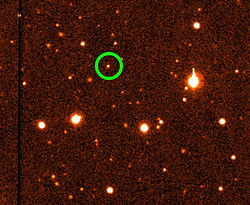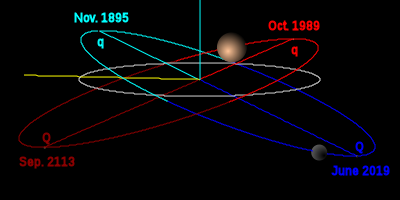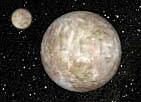90482 Orcus: Difference between revisions
→Size and magnitude: Update image description. |
m →Physical characteristics: clean up- spelling "et al." and gen fixes using AWB |
||
| Line 93: | Line 93: | ||
circle 342 1305 137 [[90377 Sedna|Sedna]] |
circle 342 1305 137 [[90377 Sedna|Sedna]] |
||
#Orcus |
#Orcus |
||
circle 1088 1305 114 |
circle 1088 1305 114 Orcus |
||
#Quaoar |
#Quaoar |
||
circle 1784 1305 97 [[50000 Quaoar|Quaoar]] |
circle 1784 1305 97 [[50000 Quaoar|Quaoar]] |
||
| Line 109: | Line 109: | ||
#Moons should be placed on "top" so that their smaller circles won't disappear "under" their respective primaries. |
#Moons should be placed on "top" so that their smaller circles won't disappear "under" their respective primaries. |
||
</imagemap> |
</imagemap> |
||
The [[absolute magnitude]] of Orcus is 2.3 (comparable with the 2.6 of [[Classical Kuiper belt object|cubewano]] [[50000 Quaoar]]). In the first quarter of 2007 a paper was published, showing the [[Spitzer space telescope]] had detected Orcus in the [[far infrared]], during its first three years in operation, constraining the diameter to 946.3{{±|74.1|72.3}} km.<ref name="Stansberry 2007">{{cite journal|last=Stansberry|first=J.| coauthors=Grundy, W.; Brown, M.; et |
The [[absolute magnitude]] of Orcus is 2.3 (comparable with the 2.6 of [[Classical Kuiper belt object|cubewano]] [[50000 Quaoar]]). In the first quarter of 2007 a paper was published, showing the [[Spitzer space telescope]] had detected Orcus in the [[far infrared]], during its first three years in operation, constraining the diameter to 946.3{{±|74.1|72.3}} km.<ref name="Stansberry 2007">{{cite journal|last=Stansberry|first=J.| coauthors=Grundy, W.; Brown, M.; et al.|title=Physical Properties of Kuiper Belt and Centaur Objects: Constraints from Spitzer Space Telescope|url=http://arxiv.org/abs/astro-ph/0702538v1|year=2007}}</ref> [[Orcus]] appears to have an [[albedo]] of ~20%,<ref name="Stansberry 2007"/> which may be typical of trans-Neptunian objects approaching the 1000 km diameter range.<ref name=tnoalbedo>{{cite web |
||
|date=2008-09-17 |
|date=2008-09-17 |
||
|title=TNO/Centaur diameters and albedos |
|title=TNO/Centaur diameters and albedos |
||
| Line 123: | Line 123: | ||
===Cryovolcanism=== |
===Cryovolcanism=== |
||
[[Spectroscopy|Spectroscopic]] observations with the [[Very Large Telescope]] (VLT) at the [[European Southern Observatory]] (ESO) in 2007 show the presence of [[ |
[[Spectroscopy|Spectroscopic]] observations with the [[Very Large Telescope]] (VLT) at the [[European Southern Observatory]] (ESO) in 2007 show the presence of [[crystal]]line water [[ice]], and possibly [[ammonia]] ice on the surface. This may indicate a renewal mechanism on the surface and geological activity.<ref name=Barucci2008>{{cite journal |
||
|last=Barucci |first=M. A. |
|last=Barucci |first=M. A. |
||
|coauthors=Merlin; Guilbert; Bergh; Doressoundiram; et |
|coauthors=Merlin; Guilbert; Bergh; Doressoundiram; et al. |
||
|title=Surface composition and temperature of the TNO Orcus |
|title=Surface composition and temperature of the TNO Orcus |
||
|journal=Astronomy and Astrophysics |
|journal=Astronomy and Astrophysics |
||
|volume=479 |issue=1 |
|volume=479 |issue=1 |pages=L13-L16 |year=2008 |
||
|doi=10.1051/0004-6361:20079079 |
|doi=10.1051/0004-6361:20079079 |
||
|url=http://adsabs.harvard.edu/abs/2008A%26A...479L..13B |
|url=http://adsabs.harvard.edu/abs/2008A%26A...479L..13B |
||
Revision as of 19:49, 21 May 2009
 | |
| Discovery[1] | |
|---|---|
| Discovered by | M. Brown, C. Trujillo, D. Rabinowitz |
| Discovery date | February 17, 2004 |
| Designations | |
| 2004 DW | |
| Plutino[2][3] Plutoid candidate | |
| Orbital characteristics[1] | |
| Epoch November 30, 2008 (JD 2 454 800) | |
| Aphelion | 7 188.17 Gm (48.05 AU) |
| Perihelion | 4 535.80 Gm (30.32 AU) |
| 5 862.44 Gm (39.188 AU) | |
| Eccentricity | 0.226 18 |
| 89 606 d (245.33 yr) | |
Average orbital speed | 4.68 km/s |
| 164.68° | |
| Inclination | 20.593° |
| 268.722° | |
| 72.474° | |
| Known satellites | 1 (92-432 km) |
| Physical characteristics | |
| Dimensions | 946.3 +74.1 −72.3 km (diameter)[4] |
| Mass | ~7×1020 kg |
Mean density | ~1.6 g/cm³ (comparable to that of Charon)[5] |
| ~0.2 m/s² | |
| ~0.44 km/s | |
| 10.08 ± 0.01 hr[5] | |
| Albedo | 19.75 +3.40 −2.76 %[4] |
| Temperature | ~44 K[5] |
Spectral type | B-V=0.68; V-R=0.37[6](neutral color)[5] |
| 19.1 (opposition)[7][8] | |
| 2.3[1] | |
90482 Orcus (Template:Pron-en OR-kəs, Latin: Orcus, originally known by the provisional designation 2004 DW) is a Kuiper Belt object (KBO) and a likely dwarf planet that was discovered by Michael Brown of Caltech, Chad Trujillo of the Gemini Observatory, and David Rabinowitz of Yale University. The discovery images of this object were acquired on February 17, 2004. Precovery images as early as November 8, 1951 were later identified.[1]
Orbit
Orcus is a large plutino (an object in 2:3 orbital resonance with Neptune).[2] Orcus's 247 year orbit is shaped similarly to Pluto's (both have perihelia above the ecliptic), but is differently oriented. Although at one point its orbit approaches that of Neptune, the resonance between the two bodies means that Orcus itself is always a great distance away from Neptune (there is always an angular separation of over 60 degrees between them). Over a 14,000 year period Orcus stays more than 18 AU from Neptune.[9] Because their mutual resonance with Neptune constrains Orcus and Pluto to remain on opposite sides of the Sun in their otherwise very similar motions, Orcus is sometimes described as the "anti-Pluto".[10]


Orcus is currently 47.8 AU from the Sun[7] and will come to aphelion (farthest distance from the Sun) in 2019.[8] Simulations by the Deep Ecliptic Survey (DES) show that over the next 10 million years Orcus can acquire a perihelion distance (qmin) as small as 27.8 AU.[2]
Physical characteristics
Size and magnitude
Error: Image is invalid or non-existent.
The absolute magnitude of Orcus is 2.3 (comparable with the 2.6 of cubewano 50000 Quaoar). In the first quarter of 2007 a paper was published, showing the Spitzer space telescope had detected Orcus in the far infrared, during its first three years in operation, constraining the diameter to 946.3+74.1
−72.3 km.[4] Orcus appears to have an albedo of ~20%,[4] which may be typical of trans-Neptunian objects approaching the 1000 km diameter range.[11]
Colours and spectra
Infrared observations in 2004 by the European Southern Observatory give results consistent with mixtures of water ice and carbonaceous compounds, such as tholins.[12] Further, the infrared spectra taken with the Gemini telescope confirmed a modest water ice signature, compatible with a cover of 15–30%, but no more than 50% of the surface.[13] This means there is less ice than on Charon, but a similar amount to that on Triton. Limitations were also placed on the amount of methane ice (less than 30%) leaving open the possibility for discovery of other components in the future.[13]
KBOs display a diversity of colours and spectra even among objects with similar orbits. Orcus presents a neutral colour in comparison with the redness of plutinos like Ixion or Huya.
Cryovolcanism
Spectroscopic observations with the Very Large Telescope (VLT) at the European Southern Observatory (ESO) in 2007 show the presence of crystalline water ice, and possibly ammonia ice on the surface. This may indicate a renewal mechanism on the surface and geological activity.[5] Ammonia has not been detected on any icy satellite of the outer planets other than Miranda.[5] The 1.65 μm band is large and deep (12%), as on Charon, Quaoar , Haumea (2003 EL61), and icy satellites of giant planets.[5] Water ice irradiation to the conditions of a trans-Neptunian object (TNO) at 40 AU indicates that crystalline water ice on the surface of TNOs should be completely amorphized by irradiation in about 10 million years.[5] Cryovolcanism, which is considered the most probable mechanism to explain geological activity on some satellites of the outer planets, may indeed be possible for TNOs larger than about 1000 km.[5]
Satellite

Using observations with the Hubble Space Telescope from November 13, 2005, Mike Brown and T.A. Suer detected a satellite.[14] The discovery of a satellite of Orcus was reported in IAUC 8812 on 22 February, 2007.[15] The satellite has been given the designation S/1 90482 (2005). It orbits Orcus "in a tight precise circle", with an orbital period of approximately 10 days.[10] Mike Brown also suspects that like the Pluto-Charon system, Orcus and its moon are likely tidally locked.[10]
The satellite was found at 0.25 arcsec from Orcus with magnitude difference of 2.7±1.[14] Assuming an albedo similar to that of the primary, the magnitude suggests a quite substantial diameter; perhaps ~250 km or about 1/4th to 1/3rd the diameter of Orcus.[15] The satellite does not resemble other known collisional satellites and may be a captured KBO.[10]
On March 23, 2009, Brown asked readers of his weekly column to suggest possible names for the satellite, with the best one to be submitted to the International Astronomical Union (IAU) on April 5.[10] The name Vanth, after the Etruscan goddess who guided the souls of the dead to the underworld, was eventually chosen from among a large pool of submissions.[16] This submission will be assessed by the IAU's Committee for Small Body Nomenclature, which will vote on whether to approve it, in accordance with the normal object naming procedures.[17]
Name
Under the guidelines of the International Astronomical Union's naming conventions, objects with a similar size and orbit to that of Pluto are named after underworld deities. Accordingly, the discoverers suggested naming the object after Orcus, a god of the dead in Etruscan and Roman mythology. The name was also a private reference to the homonymous Orcas Island, where Brown's wife Diane had lived as a child and which they visit frequently.[16] Orcus was approved and published on November 22, 2004.
External links and sources
- MPEC 2004-D09 announcing the discovery but attributing it to Raymond J. Bambery, Steven H. Pravdo, Michael D. Hicks, Kenneth J. Lawrence, Daniel MacDonald, Eleanor F. Helin and Robert Thicksten / NEAT
- MPEC 2004-D13 correcting MPEC 2004-D09
- Chad Trujillo's page on 2004 DW
- First BBC article
- AstDys orbital elements
- Orbital simulation from JPL (Java) / Ephemeris
References
- ^ a b c d "JPL Small-Body Database Browser: 90482 Orcus (2004 DW)". 2008-02-10 last obs. Retrieved 2008-07-02.
{{cite web}}: Check date values in:|date=(help) - ^ a b c Buie, Marc W. (2007-12-22). "Orbit Fit and Astrometric record for 90482". SwRI (Space Science Department). Retrieved 2008-09-19.
- ^ "MPEC 2009-E53 : DISTANT MINOR PLANETS (2009 MAR. 30.0 TT)". Minor Planet Center. 2009-03-11. Retrieved 2009-03-25.
- ^ a b c d Stansberry, J. (2007). "Physical Properties of Kuiper Belt and Centaur Objects: Constraints from Spitzer Space Telescope".
{{cite journal}}: Cite journal requires|journal=(help); Unknown parameter|coauthors=ignored (|author=suggested) (help) - ^ a b c d e f g h i Barucci, M. A. (2008). "Surface composition and temperature of the TNO Orcus". Astronomy and Astrophysics. 479 (1): L13–L16. doi:10.1051/0004-6361:20079079. Retrieved 2009-03-29.
{{cite journal}}: Unknown parameter|coauthors=ignored (|author=suggested) (help) - ^ Tegler, Stephen C. (2006-01-26). "Kuiper Belt Object Magnitudes and Surface Colors". Retrieved 2006-11-05.
{{cite web}}: Cite has empty unknown parameter:|coauthors=(help) - ^ a b "AstDys (90482) Orcus Ephemerides". Department of Mathematics, University of Pisa, Italy. Retrieved 2009-03-19.
- ^ a b "HORIZONS Web-Interface". JPL Solar System Dynamics. Retrieved 2008-07-02.
{{cite web}}: External link in|publisher= - ^ "MPEC 2004-D15 : 2004 DW". Minor Planet Center. 2004-02-20. Retrieved 2009-01-30.
- ^ a b c d e Michael E. Brown (2009-03-23). "S/1 90482 (2005) needs your help". Mike Brown's Planets (blog). Retrieved 2009-03-25.
- ^ Wm. Robert Johnston (2008-09-17). "TNO/Centaur diameters and albedos". Johnston's Archive. Retrieved 2008-10-17.
- ^ de Bergh, C. (2005). "The Surface of the Transneptunian Object 9048 Orcus". Astronomy & Astrophysics. 437: 1115–1120. doi:10.1051/0004-6361:20042533.
{{cite journal}}: Unknown parameter|coauthors=ignored (|author=suggested) (help) - ^ a b Chadwick A. Trujillo, Michael E. Brown, David L. Rabinowitz, Thomas R. Geballe (2005). "Near Infrared Surface Properties of the Two Intrinsically Brightest Minor Planets (90377) Sedna and (90482) Orcus". The Astrophysical Journal. 627: 1057–1065. doi:10.1086/430337.
{{cite journal}}: CS1 maint: multiple names: authors list (link) Preprint on arXiv. - ^ a b Daniel W. E. Green (2007-02-22). "IAUC 8812: Sats OF 2003 AZ_84, (50000), (55637),, (90482)". International Astronomical Union Circular. Retrieved 2009-03-26.
- ^ a b Wm. Robert Johnston (2007-03-04). "(90482) Orcus". Johnston's Archive. Retrieved 2009-03-26.
- ^ a b Michael E. Brown (2009-04-06). "Orcus Porcus". Mike Brown's Planets (blog). Retrieved 2009-04-06.
- ^ "Committee on Small Body Nomenclature: Names of Minor Planets". Retrieved 2009-04-08.


